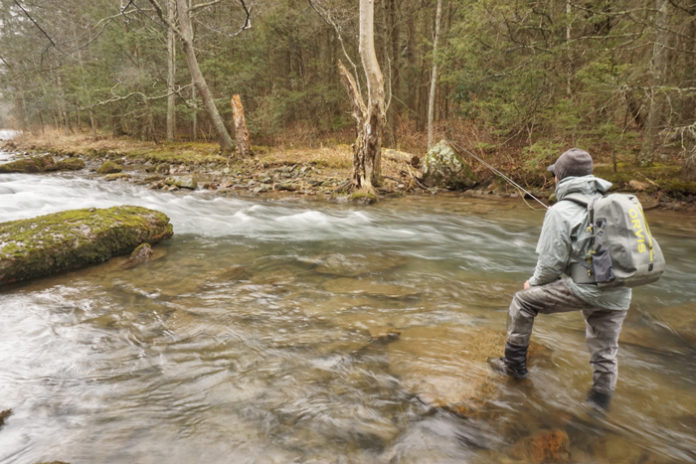Written by: George Daniel, Livin On The Fly
The head of a run is a like a food funnel for trout, so the big ones will often nab this prime lie.
Photos courtesy George Daniel
No, this is not about your bladder and its relation to fishing. Instead, it’s a fishing bum’s opinion on where some of the best fish hold during peak hatch season. Here in central Pennsylvania, some of our peak hatches occur from late April through early June. The largest trout in the stream get that way by taking up the best feeding lie in the stream. During this time, I’ve observed that some of the best fish take feeding position at the head (i.e. top part) of most runs and riffles. This may mean a twenty-inch fish holding in just three or four inches of water.
Why? One possible explanation is that the majority of our insects live in heavily riffled sections, and the head of such runs or riffles acts a food funnel for the trout. This can be especially important during hatches when insects dislodge from stream bottom as they migrate toward the surface to hatch. In these situations, the head of a run concentrates a lot of food within a small area.
These fish are more prone to spook because they are holding in a skinny water, where predators have easier access, so take extra caution when approaching such water. There’s a reason why a quality fish will continuously fight a strong current while holding in only inches of water: there’s abundance of food. The return on investment is worth the potential danger.

It pays to run a nymph on a tight line through the head of a run.
Recently I fished a popular stretch of a central-Pennsylvania spring creek. Both tan caddisflies and sulfurs were hatching in the early afternoon, and after catching a couple trout, I decided to sit down along a high bank to see if I could find a few trout to sight-fish to. At the top of a run was a 16-to-17-inch brown trout (a large trout for that stretch), in three inches of water. Seeing trout hold in skinny water isn’t necessarily unusual on this stream; what was interesting was the frequency with which this fish was feeding. Every four or five seconds, this fish was sliding right or left picking off drifting nymphs. This went on for five minutes before I couldn’t resist and made a cast to fish. The trout immediately pulled left and inhaled my nymph the moment it came in contact with the water.
The lesson here is to be ready for the strike to occur the moment the fly lands, especially when you’re fishing the head of a run or riffle. Things will happen fast, often faster than the angler can react to. This is why I prefer to use a tight-line nymphing rig, where you are in contact the moment the nymphs land on the water. You might think you’ve hit bottom because you’re using a heavy nymph in skinning water, but my limited experience that tells me it’s likely a trout instantly jumping on a nymph.
While this feeding position can take place throughout the year on my home waters, springtime is when I see it occur with the most consistently. However, I urge you to experiment “hitting the head” on your home waters during peak hatch season. You may be surprised to see some of the actively feeding big fish take position at the head.
George Daniel operates Livin On The Fly, a guide service in State College, Pennsylvania. He is also the author of Strip-Set: Fly-Fishing Techniques, Tactics, & Patterns for Streamers, as well as Dynamic Nymphing.
Credit: Source link






























